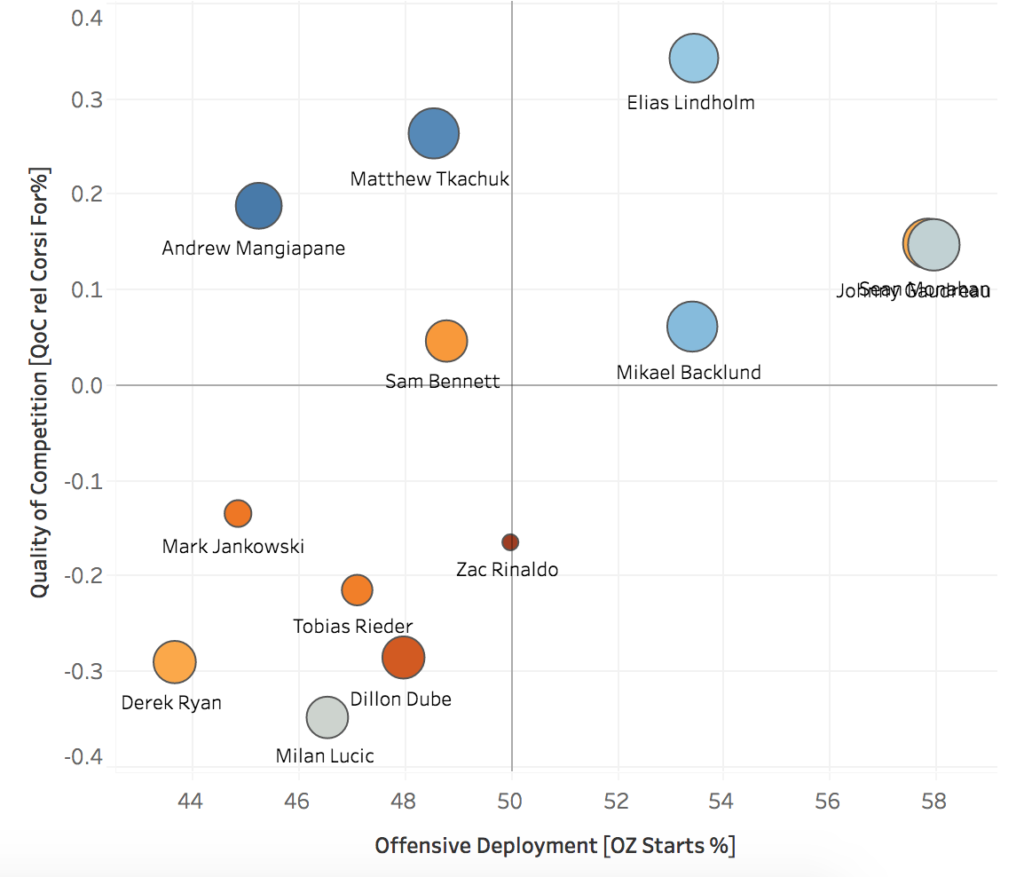Should the Flames go short or long term with Andrew Mangiapane?

By Ryan Pike
3 years agoOn Thursday, the Calgary Flames reached an agreement with restricted free agent Tyler Parsons on a new deal. That signing cut Brad Treliving’s list of unfinished off-season tasks to just two: re-signing RFAs Oliver Kylington and Andrew Mangiapane.
Mangiapane’s deal may be the most interesting signing of the off-season period for the Flames, as there are pros and cons to trying to hammer out a long term deal or a shorter pact.
The case for short term
A season ago, the Flames opted to hammer out a short, inexpensive deal with Mangiapane – he ended up getting a one-way deal worth just above league minimum salary at $715,000. Part of the reasoning for that was the team’s tight cap structure – they had to settle for a bridge deal with Matthew Tkachuk, after all – but also because of Mangiapane’s minuscule sample size at the NHL level. He’d played 54 games and it wasn’t clear what he was. Sure, he had a superb 2018-19 second half on the fourth line, but what else could he do.
Well, a season later it’s a bit clearer what he is – he’s good at hockey, folks – but with a 122 game NHL sample, still small, it’s not clear what his ceiling is. And with other wingers like Sam Bennett and Dillon Dube kicking around and vying for ice time and roles, there’s a risk of going “Oh cool, Mangiapane’s a top six guy, let’s pay him like one,” and then Bennett or Dube supplants him and you have a pricey depth guy. A bigger sample size would allay some of those fears.
But let’s be honest with each other: the most compelling reasons to go shorter with Mangiapane right now are cap space and logistics. Signing a short deal with Mangiapane likely involves a $2.3-$2.5 million cap hit. Going longer involves buying UFA years, and suddenly the AAV starts with a four. The Flames would need to move out cap hits to fit Mangiapane in, and it’s unclear what they would look like.
Want the Flames to have a shot at winning in the next year or two? Go short with Mangiapane.
The case for long term
So, in August I wrote a piece that called Mangiapane the Flames’ best player. Looking at the sample size of the past season, I singled him out. Why? Because he was the best all-around player on the team.
Here’s a player usage chart of the Flames’ forwards in 2019-20. The higher up a player is, the tougher opposition they play against. The further to the left they play, the more often they start in the defensive zone. And bluer is better in terms of possession metrics.
Where’s Mangiapane?

Only two players consistently faced roughly waters than Mangiapane: Elias Lindholm and Tkachuk. And both of those players started shifts more frequently in the offensive end than Mangiapane did.
Here’s five on five offensive production, via Natural Stat Trick, sorted by time on ice:

Sixth in ice time, second in goals, first in primary points, and tied for second in points. He’s good at generating offense. As the prior chart reflected, he’s good at possession hockey despite getting some of the toughest deployments on the team.
Mikael Backlund is arguably the most beloved two-way player in Flames history. It took him years to become his fully-formed self at the NHL level. While not a centre, Mangiapane is almost Backlund-good at two-way hockey and may be better than him already at generating offense.
Sure, signing Mangiapane long-term carries some risks. Maybe he’ll regress. But signing him long-term now and buying some UFA years hedges against the possibility that he could get even better and command a bigger salary in another year or two.
If the Flames believe in the player, it would make a lot of sense to hammer out a long-term deal and do what needs to be done to make it work. Sure, logistics might be a challenge, but it would be short term pain for long term gain.
Recent articles from Ryan Pike





